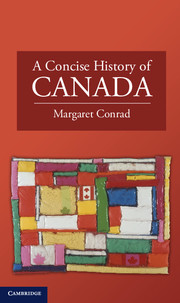Book contents
- Frontmatter
- Contents
- Illustrations
- Acknowledgements
- Introduction A Cautious Country
- 1 Since Time Immemorial
- 2 Natives and Newcomers, 1000–1661
- 3 New France, 1661–1763
- 4 A Revolutionary Age, 1763–1821
- 5 Transatlantic Communities, 1815–1849
- 6 Coming Together, 1849–1885
- 7 Making Progress, 1885–1914
- 8 Hanging On, 1914–1945
- 9 Liberalism Triumphant, 1945–1984
- 10 Interesting Times, 1984–2011
- Notes
- Guide to Further Reading
- Index
3 - New France, 1661–1763
Published online by Cambridge University Press: 05 June 2012
- Frontmatter
- Contents
- Illustrations
- Acknowledgements
- Introduction A Cautious Country
- 1 Since Time Immemorial
- 2 Natives and Newcomers, 1000–1661
- 3 New France, 1661–1763
- 4 A Revolutionary Age, 1763–1821
- 5 Transatlantic Communities, 1815–1849
- 6 Coming Together, 1849–1885
- 7 Making Progress, 1885–1914
- 8 Hanging On, 1914–1945
- 9 Liberalism Triumphant, 1945–1984
- 10 Interesting Times, 1984–2011
- Notes
- Guide to Further Reading
- Index
Summary
Between 1661 and 1763, France built a great empire in North America and then lost most of it to the British. Louis XIV laid the foundations for the growth of New France and also sowed the seeds of its decline. In extending its grasp, France laid claim to Newfoundland, Acadia, Canada, Louisiana, and several islands in the West Indies, along with vast areas of the interior of the North American continent occupied by Aboriginal allies and loosely held together by a network of fortified trading posts. New France was many things, but above all, it represented a remarkable case of a colonial jurisdiction punching above its weight.
FOUNDATIONS OF AN EMPIRE
Louis XIV’s decision in 1661 to assume personal charge of state affairs was a significant event, not only for France and its colonies, but also for Europe and the world. By creating bureaucratic structures, legal regimes, military might, and symbolic gestures to sustain monarchical powers against the claims of the nobility, the papacy, and other nations, the so-called Sun King emerged as the most powerful force in European affairs. His efforts to dominate Europe during his long reign, which ended in 1715, sparked a series of wars that echoed around the world and ultimately led to the fall of New France (Image 3.1).
- Type
- Chapter
- Information
- A Concise History of Canada , pp. 51 - 79Publisher: Cambridge University PressPrint publication year: 2012

